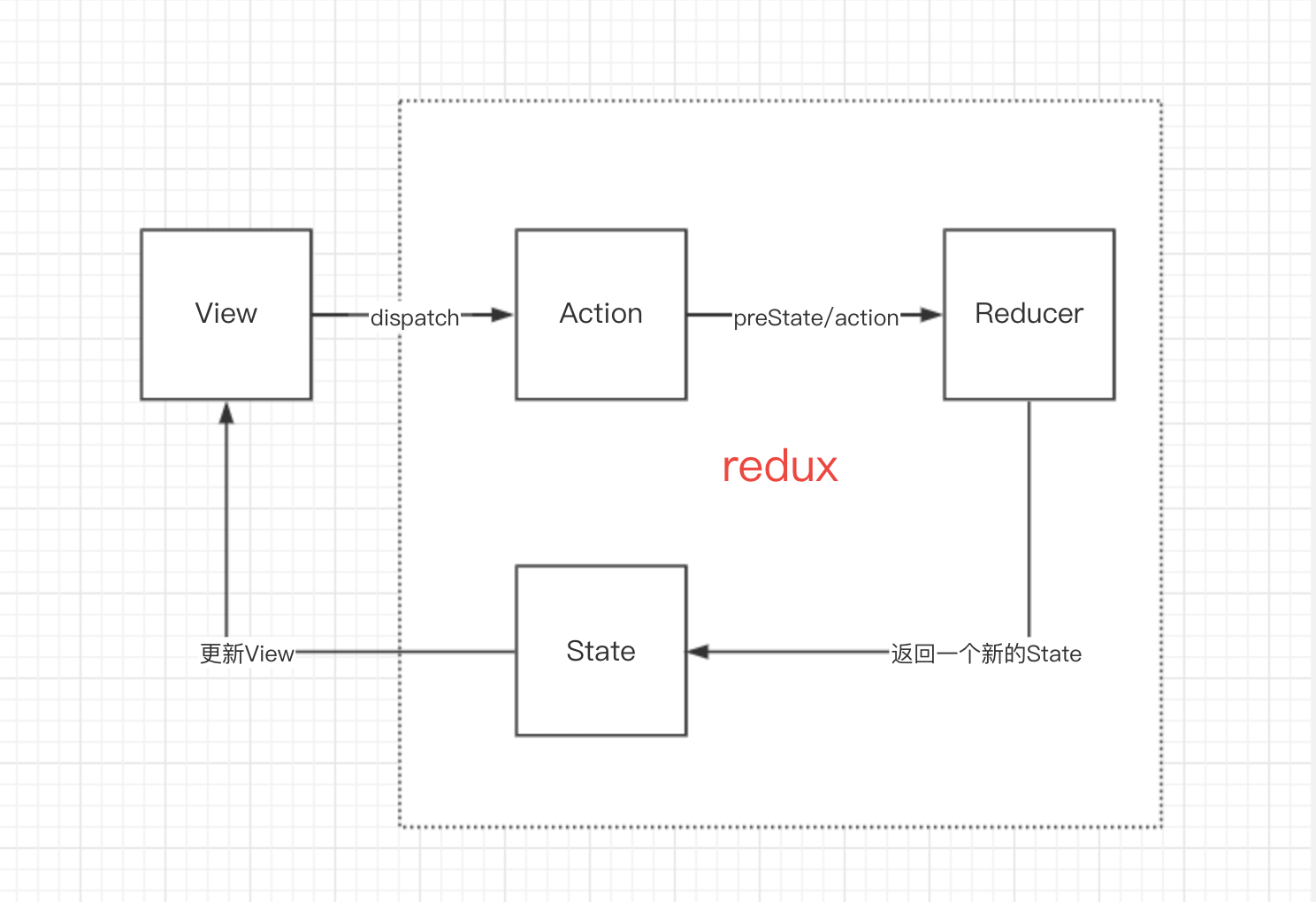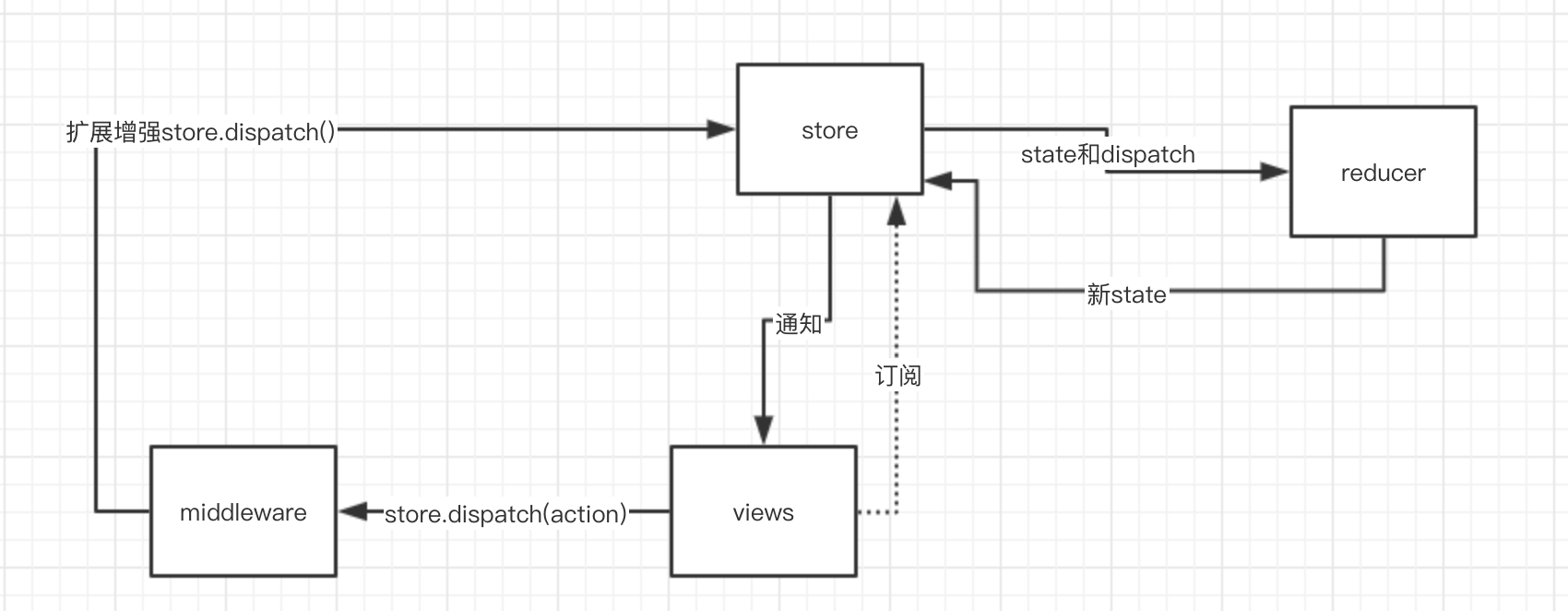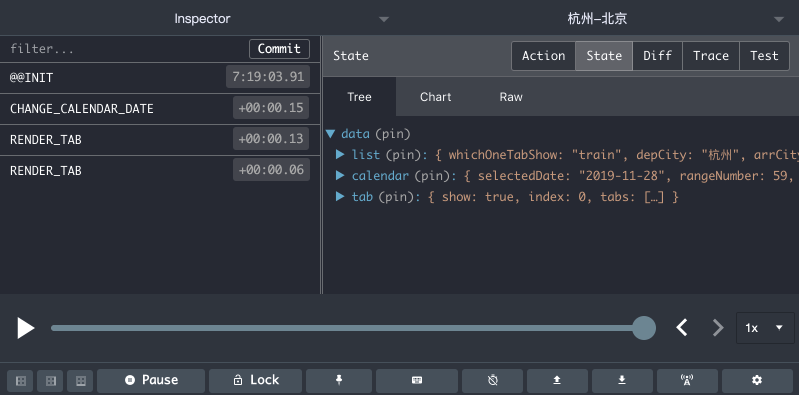詳解JavaScript狀態容器Redux
在說為什么用 Redux 之前,讓我們先聊聊組件通信有哪些方式。常見的組件通信方式有以下幾種:
父子組件:props、state/callback回調來進行通信 單頁面應用:路由傳值 全局事件比如EventEmitter監聽回調傳值 react中跨層級組件數據傳遞Context(上下文)在小型、不太復雜的應用中,一般用以上幾種組件通信方式基本就足夠了。
但隨著應用逐漸復雜,數據狀態過多(比如服務端響應數據、瀏覽器緩存數據、UI狀態值等)以及狀態可能會經常發生變化的情況下,使用以上組件通信方式會很復雜、繁瑣以及很難定位、調試相關問題。
因此狀態管理框架(如 Vuex、MobX、Redux等)就顯得十分必要了,而 Redux 就是其中使用最廣、生態最完善的。
二、Redux Data flow在一個使用了 Redux 的 App應用里面會遵循下面四步:
第一步:通過store.dispatch(action)來觸發一個action,action就是一個描述將要發生什么的對象。如下:
{ type: ’LIKE_ARTICLE’, articleId: 42 }{ type: ’FETCH_USER_SUCCESS’, response: { id: 3, name: ’Mary’ } }{ type: ’ADD_TODO’, text: ’金融前端.’ }
第二步:Redux會調用你提供的 Reducer函數。
第三步:根 Reducer 會將多個不同的 Reducer 函數合并到單獨的狀態樹中。
第四步:Redux store會保存從根 Reducer 函數返回的完整狀態樹。
所謂一圖勝千言,下面我們結合 Redux 的數據流圖來熟悉這一過程。

1、Single source of truth:單一數據源,整個應用的state被存儲在一個對象樹中,并且只存在于唯一一個store中。
2、State is read-only:state里面的狀態是只讀的,不能直接去修改state,只能通過觸發action來返回一個新的state。
3、Changes are made with pure functions:要使用純函數來修改state。
四、Redux源碼解析Redux 源碼目前有js和ts版本,本文先介紹 js 版本的 Redux 源碼。Redux 源碼行數不多,所以對于想提高源碼閱讀能力的開發者來說,很值得前期來學習。
Redux源碼主要分為6個核心js文件和3個工具js文件,核心js文件分別為index.js、createStore.js、compose.js、combineRuducers.js、bindActionCreators.js和applyMiddleware.js文件。
接下來我們來一一學習。
4.1、index.jsindex.js是入口文件,提供核心的API,如createStore、combineReducers、applyMiddleware等。
export { createStore, combineReducers, bindActionCreators, applyMiddleware, compose, __DO_NOT_USE__ActionTypes}4.2、createStore.js
createStore是 Redux 提供的API,用來生成唯一的store。store提供getState、dispatch、subscibe等方法,Redux 中的store只能通過dispatch一個action,通過action來找對應的 Reducer函數來改變。
export default function createStore(reducer, preloadedState, enhancer) {...}
從源碼中可以知道,createStore接收三個參數:Reducer、preloadedState、enhancer。
Reducer是action對應的一個可以修改store中state的純函數。
preloadedState代表之前state的初始化狀態。
enhancer是中間件通過applyMiddleware生成的一個加強函數。store中的getState方法是獲取當前應用中store中的狀態樹。
/** * Reads the state tree managed by the store. * * @returns {any} The current state tree of your application. */function getState() { if (isDispatching) { throw new Error( ’You may not call store.getState() while the reducer is executing. ’ +’The reducer has already received the state as an argument. ’ +’Pass it down from the top reducer instead of reading it from the store.’ ) } return currentState}
dispatch方法是用來分發一個action的,這是唯一的一種能觸發狀態發生改變的方法。subscribe是一個監聽器,當一個action被dispatch的時候或者某個狀態發生改變的時候會被調用。
4.3、combineReducers.js/** * Turns an object whose values are different reducer functions, into a single * reducer function. It will call every child reducer, and gather their results * into a single state object, whose keys correspond to the keys of the passed * reducer functions. */export default function combineReducers(reducers) { const reducerKeys = Object.keys(reducers) ... return function combination(state = {}, action) { ... let hasChanged = false const nextState = {} for (let i = 0; i < finalReducerKeys.length; i++) { const key = finalReducerKeys[i] const reducer = finalReducers[key] const previousStateForKey = state[key] const nextStateForKey = reducer(previousStateForKey, action) if (typeof nextStateForKey === ’undefined’) {const errorMessage = getUndefinedStateErrorMessage(key, action)throw new Error(errorMessage) } nextState[key] = nextStateForKey //判斷state是否發生改變 hasChanged = hasChanged || nextStateForKey !== previousStateForKey } //根據是否發生改變,來決定返回新的state還是老的state return hasChanged ? nextState : state }}
從源碼可以知道,入參是 Reducers,返回一個function。combineReducers就是將所有的 Reducer合并成一個大的 Reducer 函數。核心關鍵的地方就是每次 Reducer 返回新的state的時候會和老的state進行對比,如果發生改變,則hasChanged為true,觸發頁面更新。反之,則不做處理。
4.4、bindActionCreators.js/** * Turns an object whose values are action creators, into an object with the * same keys, but with every function wrapped into a `dispatch` call so they * may be invoked directly. This is just a convenience method, as you can call * `store.dispatch(MyActionCreators.doSomething())` yourself just fine. */function bindActionCreator(actionCreator, dispatch) { return function() { return dispatch(actionCreator.apply(this, arguments)) }} export default function bindActionCreators(actionCreators, dispatch) { if (typeof actionCreators === ’function’) { return bindActionCreator(actionCreators, dispatch) } ... ... const keys = Object.keys(actionCreators) const boundActionCreators = {} for (let i = 0; i < keys.length; i++) { const key = keys[i] const actionCreator = actionCreators[key] if (typeof actionCreator === ’function’) { boundActionCreators[key] = bindActionCreator(actionCreator, dispatch) } } return boundActionCreators}
bindActionCreator是將單個actionCreator綁定到dispatch上,bindActionCreators就是將多個actionCreators綁定到dispatch上。
bindActionCreator就是將發送actions的過程簡化,當調用這個返回的函數時就自動調用dispatch,發送對應的action。
bindActionCreators根據不同類型的actionCreators做不同的處理,actionCreators是函數就返回函數,是對象就返回一個對象。主要是將actions轉化為dispatch(action)格式,方便進行actions的分離,并且使代碼更加簡潔。
4.5、compose.js/** * Composes single-argument functions from right to left. The rightmost * function can take multiple arguments as it provides the signature for * the resulting composite function. * * @param {...Function} funcs The functions to compose. * @returns {Function} A function obtained by composing the argument functions * from right to left. For example, compose(f, g, h) is identical to doing * (...args) => f(g(h(...args))). */ export default function compose(...funcs) { if (funcs.length === 0) { return arg => arg } if (funcs.length === 1) { return funcs[0] } return funcs.reduce((a, b) => (...args) => a(b(...args)))}
compose是函數式變成里面非常重要的一個概念,在介紹compose之前,先來認識下什么是 Reduce?官方文檔這么定義reduce:reduce()方法對累加器和數組中的每個元素(從左到右)應用到一個函數,簡化為某個值。compose是柯里化函數,借助于Reduce來實現,將多個函數合并到一個函數返回,主要是在middleware中被使用。
4.6、applyMiddleware.js/** * Creates a store enhancer that applies middleware to the dispatch method * of the Redux store. This is handy for a variety of tasks, such as expressing * asynchronous actions in a concise manner, or logging every action payload. */export default function applyMiddleware(...middlewares) { return createStore => (...args) => { const store = createStore(...args) ... ... return { ...store, dispatch } }}
applyMiddleware.js文件提供了middleware中間件重要的API,middleware中間件主要用來對store.dispatch進行重寫,來完善和擴展dispatch功能。
那為什么需要中間件呢?
首先得從Reducer說起,之前 Redux三大原則里面提到了reducer必須是純函數,下面給出純函數的定義:
對于同一參數,返回同一結果 結果完全取決于傳入的參數 不產生任何副作用至于為什么reducer必須是純函數,可以從以下幾點說起?
因為 Redux 是一個可預測的狀態管理器,純函數更便于 Redux進行調試,能更方便的跟蹤定位到問題,提高開發效率。 Redux 只通過比較新舊對象的地址來比較兩個對象是否相同,也就是通過淺比較。如果在 Reducer 內部直接修改舊的state的屬性值,新舊兩個對象都指向同一個對象,如果還是通過淺比較,則會導致 Redux 認為沒有發生改變。但要是通過深比較,會十分耗費性能。最佳的辦法是 Redux返回一個新對象,新舊對象通過淺比較,這也是 Reducer是純函數的重要原因。Reducer是純函數,但是在應用中還是會需要處理記錄日志/異常、以及異步處理等操作,那該如何解決這些問題呢?
這個問題的答案就是中間件。可以通過中間件增強dispatch的功能,示例(記錄日志和異常)如下:
const store = createStore(reducer);const next = store.dispatch; // 重寫store.dispatchstore.dispatch = (action) => { try {console.log(’action:’, action);console.log(’current state:’, store.getState());next(action);console.log(’next state’, store.getState()); } catch (error){console.error(’msg:’, error); }}五、從零開始實現一個簡單的Redux
既然是要從零開始實現一個Redux(簡易計數器),那么在此之前我們先忘記之前提到的store、Reducer、dispatch等各種概念,只需牢記Redux是一個狀態管理器。
首先我們來看下面的代碼:
let state = { count : 1}//修改之前console.log (state.count);//修改count的值為2state.count = 2;//修改之后console.log (state.count);
我們定義了一個有count字段的state對象,同時能輸出修改之前和修改之后的count值。但此時我們會發現一個問題?就是其它如果引用了count的地方是不知道count已經發生修改的,因此我們需要通過訂閱-發布模式來監聽,并通知到其它引用到count的地方。因此我們進一步優化代碼如下:
let state = { count: 1};//訂閱function subscribe (listener) { listeners.push(listener);}function changeState(count) { state.count = count; for (let i = 0; i < listeners.length; i++) {const listener = listeners[i];listener();//監聽 }}
此時我們對count進行修改,所有的listeners都會收到通知,并且能做出相應的處理。但是目前還會存在其它問題?比如說目前state只含有一個count字段,如果要是有多個字段是否處理方式一致。同時還需要考慮到公共代碼需要進一步封裝,接下來我們再進一步優化:
const createStore = function (initState) { let state = initState; //訂閱 function subscribe (listener) {listeners.push(listener); } function changeState (count) {state.count = count;for (let i = 0; i < listeners.length; i++) { const listener = listeners[i]; listener();//通知} } function getState () {return state; } return {subscribe,changeState,getState }}
我們可以從代碼看出,最終我們提供了三個API,是不是與之前Redux源碼中的核心入口文件index.js比較類似。但是到這里還沒有實現Redux,我們需要支持添加多個字段到state里面,并且要實現Redux計數器。
let initState = { counter: {count : 0 }, info: {name: ’’,description: ’’ }}let store = createStore(initState);//輸出countstore.subscribe(()=>{ let state = store.getState(); console.log(state.counter.count);});//輸出infostore.subscribe(()=>{ let state = store.getState(); console.log(`${state.info.name}:${state.info.description}`);});
通過測試,我們發現目前已經支持了state里面存多個屬性字段,接下來我們把之前changeState改造一下,讓它能支持自增和自減。
//自增store.changeState({ count: store.getState().count + 1});//自減store.changeState({ count: store.getState().count - 1});//隨便改成什么store.changeState({ count: 金融});
我們發現可以通過changeState自增、自減或者隨便改,但這其實不是我們所需要的。我們需要對修改count做約束,因為我們在實現一個計數器,肯定是只希望能進行加減操作的。所以我們接下來對changeState做約束,約定一個plan方法,根據type來做不同的處理。
function plan (state, action) => { switch (action.type) { case ’INCREMENT’: return {...state,count: state.count + 1 } case ’DECREMENT’: return {...state,count: state.count - 1 } default: return state }}let store = createStore(plan, initState);//自增store.changeState({ type: ’INCREMENT’});//自減store.changeState({ type: ’DECREMENT’});
我們在代碼中已經對不同type做了不同處理,這個時候我們發現再也不能隨便對state中的count進行修改了,我們已經成功對changeState做了約束。我們把plan方法做為createStore的入參,在修改state的時候按照plan方法來執行。到這里,恭喜大家,我們已經用Redux實現了一個簡單計數器了。
這就實現了 Redux?這怎么和源碼不一樣啊
然后我們再把plan換成reducer,把changeState換成dispatch就會發現,這就是Redux源碼所實現的基礎功能,現在再回過頭看Redux的數據流圖是不是更加清晰了。

Redux devtools是Redux的調試工具,可以在Chrome上安裝對應的插件。對于接入了Redux的應用,通過 Redux devtools可以很方便看到每次請求之后所發生的改變,方便開發同學知道每次操作后的前因后果,大大提升開發調試效率。

如上圖所示就是 Redux devtools的可視化界面,左邊操作界面就是當前頁面渲染過程中執行的action,右側操作界面是State存儲的數據,從State切換到action面板,可以查看action對應的 Reducer參數。切換到Diff面板,可以查看前后兩次操作發生變化的屬性值。
七、總結Redux 是一款優秀的狀態管理器,源碼短小精悍,社區生態也十分成熟。如常用的react-redux、dva都是對 Redux 的封裝,目前在大型應用中被廣泛使用。這里推薦通過Redux官網以及源碼來學習它核心的思想,進而提升閱讀源碼的能力。
以上就是詳解JavaScript狀態容器Redux的詳細內容,更多關于JavaScript狀態容器Redux的資料請關注好吧啦網其它相關文章!
相關文章:

 網公網安備
網公網安備